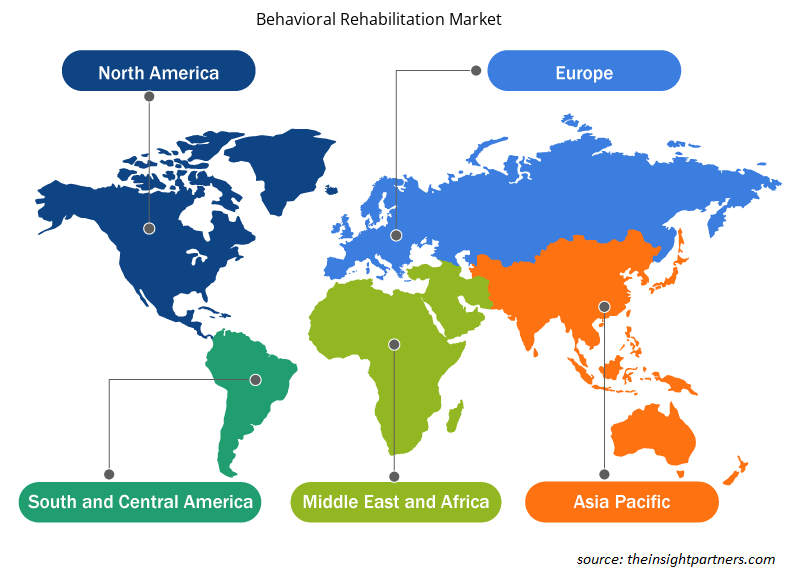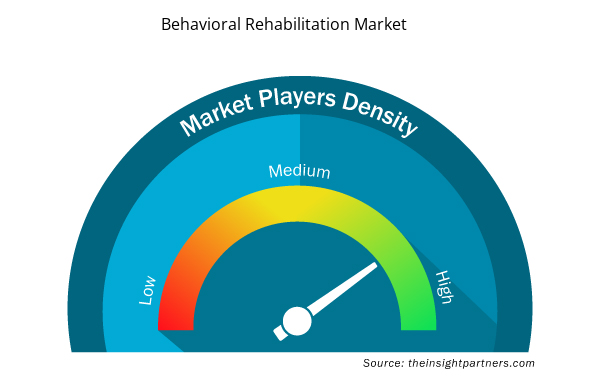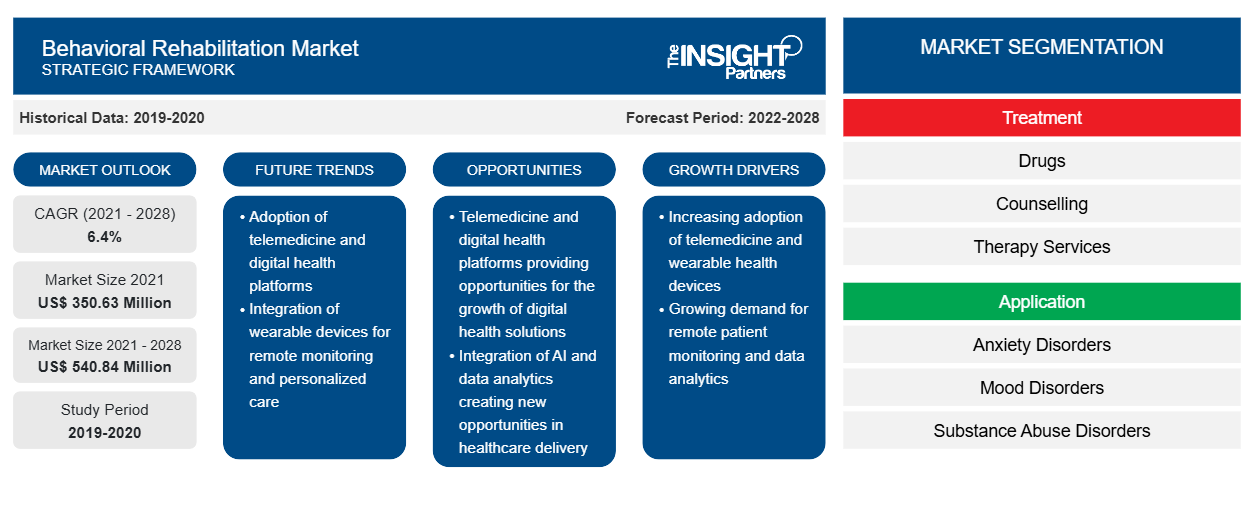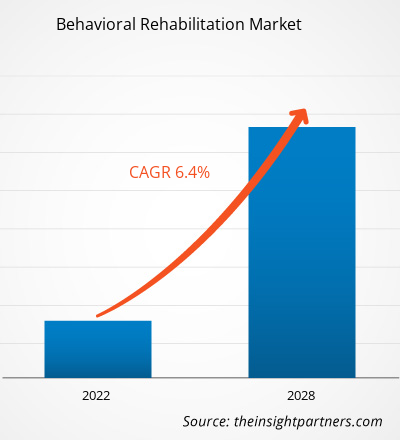Le marché de la réadaptation comportementale devrait passer de 350,63 millions USD en 2021 à 540,84 millions USD en 2028 ; il devrait croître à un TCAC de 6,4 % entre 2021 et 2028.
Les gens peuvent tomber dans plusieurs addictions comportementales pour diverses raisons, affectant gravement leur santé et leur bien-être à long terme. La réadaptation comportementale est une méthodologie largement utilisée pour sortir les patients de leurs habitudes comportementales. Les addictions comportementales sont les mêmes que les addictions liées à la toxicomanie. Les patients doivent généralement suivre différents cours méthodologiques et prendre différents médicaments. Les activités de réadaptation comportementale sont prescrites pour une période prolongée. La thérapie de réadaptation est mise en œuvre par des professionnels qui comprennent les addictions spécifiques.
L’augmentation de la prévalence des troubles du comportement, la disponibilité facile des thérapies de réadaptation comportementale et l’augmentation du nombre de lancements de produits stimulent le marché.
Personnalisez ce rapport en fonction de vos besoins
Vous bénéficierez d'une personnalisation gratuite de n'importe quel rapport, y compris de certaines parties de ce rapport, d'une analyse au niveau des pays, d'un pack de données Excel, ainsi que de superbes offres et réductions pour les start-ups et les universités.
- Obtenez les principales tendances clés du marché de ce rapport.Cet échantillon GRATUIT comprendra une analyse de données, allant des tendances du marché aux estimations et prévisions.
Informations sur le marché
Disponibilité des thérapies de réadaptation comportementale
Les troubles du comportement sont un problème courant chez les enfants et les adolescents du monde entier. Ils impliquent un ensemble de comportements perturbateurs qui durent au moins six mois, causant des problèmes à la maison, à l'école et dans d'autres situations sociales. Les troubles du comportement perturbateurs (TCD) contribuent de manière significative au vaste éventail de maladies chez les enfants et les adolescents. Classés comme troubles psychiatriques , les TCD comprennent principalement le trouble des conduites (TC) et le trouble oppositionnel avec provocation (TOP).
Selon le Centre de contrôle et de prévention des maladies (CDC), 5,1 % des enfants américains âgés de 4 à 17 ans souffrent de graves troubles émotionnels ou comportementaux, selon leurs parents. Les troubles émotionnels et comportementaux touchent 10 à 15 % des enfants dans le monde, a indiqué le National Institute of Mental Health (NIMH) dans un récent rapport. Un autre trouble comportemental courant, le trouble obsessionnel compulsif (TOC), touche environ 2 à 3 % de la population américaine. Chez les adultes, le nombre de femmes touchées est légèrement supérieur à celui des hommes. Le TOC débute souvent dans l’enfance, l’adolescence ou au début de l’âge adulte ; l’âge moyen d’apparition des symptômes est de 19 ans.
De nombreuses recherches montrent que la toxicomanie et la dépression sont traitables. Le National Institute on Drug Abuse (NIDA), qui finance plus de 85 % des recherches mondiales sur la toxicomanie et la toxicomanie, a constaté que les services de thérapie psychologique constituent l'approche thérapeutique la plus efficace. Les traitements des troubles du comportement se concentrent principalement sur le traitement comportemental et les médicaments. La formation à la gestion parentale et la thérapie familiale sont considérées comme assez efficaces pour gérer les troubles du comportement. Le traitement par thérapie cognitivo-comportementale est apparu comme le mécanisme le plus utilisé pour gérer les symptômes des troubles du comportement.NIDA), which supports more than 85% of the world's research on
Informations basées sur les applications
En fonction des applications, le marché de la réadaptation comportementale est segmenté en troubles anxieux, troubles de l'humeur, troubles liés à la toxicomanie, troubles de la personnalité et troubles du déficit de l'attention. Le segment des troubles anxieux détenait la plus grande part de marché en 2021 et devrait enregistrer le TCAC le plus élevé du marché au cours de la période de prévision.
Informations basées sur le traitement
En termes de traitement, le marché de la réadaptation comportementale est segmenté en médicaments et en services de conseil et de thérapie. Le segment des services de conseil et de thérapie détenait la plus grande part de marché en 2021 et devrait enregistrer le TCAC le plus élevé du marché au cours de la période de prévision.counselling and therapy services. The counselling and therapy service segment held the largest market share in 2021 and is anticipated to register the highest CAGR in the market during the forecast period.
Informations basées sur le contexte des soins de santé
En fonction du contexte de soins de santé, le marché de la réadaptation comportementale est segmenté en réadaptation comportementale ambulatoire, réadaptation comportementale en milieu hospitalier et réadaptation comportementale en établissement. Le segment de la réadaptation comportementale ambulatoire détenait la plus grande part de marché en 2021 et devrait enregistrer le TCAC le plus élevé du marché au cours de la période de prévision.CAGR in the market during the forecast period.
Le lancement de nouveaux produits est la stratégie la plus couramment adoptée par les entreprises pour étendre leur présence et leur portefeuille de produits sur le marché. De plus, les entreprises ont mis en œuvre diverses stratégies inorganiques telles que les fusions et acquisitions et les partenariats. Par exemple, en mars 2019, la FDA a approuvé le spray nasal Spravato (eskétamine) de Johnson & Johnson Health Care Systems Inc. pour traiter la dépression chez les adultes.
Aperçu régional du marché de la réadaptation comportementale
Les tendances et facteurs régionaux influençant le marché de la réadaptation comportementale tout au long de la période de prévision ont été expliqués en détail par les analystes d’Insight Partners. Cette section traite également des segments et de la géographie du marché de la réadaptation comportementale en Amérique du Nord, en Europe, en Asie-Pacifique, au Moyen-Orient et en Afrique, ainsi qu’en Amérique du Sud et en Amérique centrale.

- Obtenez les données régionales spécifiques au marché de la réadaptation comportementale
Portée du rapport sur le marché de la réadaptation comportementale
| Attribut de rapport | Détails |
|---|---|
| Taille du marché en 2021 | 350,63 millions de dollars américains |
| Taille du marché d'ici 2028 | 540,84 millions de dollars américains |
| Taux de croissance annuel moyen mondial (2021-2028) | 6,4% |
| Données historiques | 2019-2020 |
| Période de prévision | 2022-2028 |
| Segments couverts | Par traitement
|
| Régions et pays couverts | Amérique du Nord
|
| Leaders du marché et profils d'entreprises clés |
|
Densité des acteurs du marché de la réadaptation comportementale : comprendre son impact sur la dynamique des entreprises
Le marché de la réadaptation comportementale connaît une croissance rapide, tirée par la demande croissante des utilisateurs finaux en raison de facteurs tels que l'évolution des préférences des consommateurs, les avancées technologiques et une plus grande sensibilisation aux avantages du produit. À mesure que la demande augmente, les entreprises élargissent leurs offres, innovent pour répondre aux besoins des consommateurs et capitalisent sur les tendances émergentes, ce qui alimente davantage la croissance du marché.
La densité des acteurs du marché fait référence à la répartition des entreprises ou des sociétés opérant sur un marché ou un secteur particulier. Elle indique le nombre de concurrents (acteurs du marché) présents sur un marché donné par rapport à sa taille ou à sa valeur marchande totale.
Les principales entreprises opérant sur le marché de la réadaptation comportementale sont :
- Springstone, Inc.
- Centres américains de lutte contre les addictions
- Soins de santé Acadia
- Services de santé universels, Inc.
- Magellan Santé, Inc.
Avis de non-responsabilité : les sociétés répertoriées ci-dessus ne sont pas classées dans un ordre particulier.

- Obtenez un aperçu des principaux acteurs du marché de la réadaptation comportementale
Profils d'entreprise
- Springstone, Inc.
- Centres américains de lutte contre les addictions
- Acadia Healthcare, Services de santé universels, Inc.
- Magellan Santé, Inc.
- Soins de santé comportementaux Haven, Inc.
- Psychsolutions, Inc.
- BHG Holdings, LLC.
- Système de santé comportementale Aurora
- Centre médical régional Baxter
- Analyse historique (2 ans), année de base, prévision (7 ans) avec TCAC
- Analyse PEST et SWO
- Taille du marché Valeur / Volume - Mondial, Régional, Pays
- Industrie et paysage concurrentiel
- Ensemble de données Excel



Report Coverage
Revenue forecast, Company Analysis, Industry landscape, Growth factors, and Trends

Segment Covered
This text is related
to segments covered.

Regional Scope
North America, Europe, Asia Pacific, Middle East & Africa, South & Central America

Country Scope
This text is related
to country scope.
Questions fréquemment posées
The behavioral rehabilitation market. People may get into several behavioral addictions for various reasons, severely affecting their health and well-being from a long-term perspective. Behavioral rehabilitation is a fiercely used methodology to retrieve patients from behavioral habits. Behavioral addictions are the same as substance misuse addictions and usually need them to undergo different methodological courses and medications. Behavioral rehabilitation activities are prescribed for an extended period. Rehabilitation therapy is implemented by professionals who understand specific addictions.
The factors that are driving and restraining factors that will affect the behavioral rehabilitation market in the coming years. Factors such as the increasing prevalence of behavioral disorders, rising numbers of product launches and easy availability of behavioral rehabilitation therapies. However, the impact of stigma attached to behavioral disorders is expected to hampers the behavioral rehabilitation market.
The behavioral rehabilitation market based on treatment is segmented into counseling therapy services and drugs. In 2021, the counseling therapy services segment accounted for the highest share, moreover, the same segment is expected to grow at a CAGR of 6.7% in the forecast period.
The behavioral rehabilitation market Springstone, Inc, American Addiction Centers, Acadia Healthcare, Universal Health Services, Inc., Magellan Health, Inc., Haven Behavioral Healthcare, Inc., Psychsolutions, Inc., BHG Holdings, LLC., Aurora Behavioral Health System, and Baxter Regional Medical Center.
Trends and growth analysis reports related to Life Sciences : READ MORE..
The List of Companies - Behavioral Rehabilitation Market
- Springstone, Inc.
- American Addiction Centers
- Acadia Healthcare
- Universal Health Services, Inc.
- Magellan Health, Inc.
- Haven Behavioral Healthcare, Inc.
- PsychSolutions, Inc.
- BHG Holdings, LLC.
- Aurora Behavioral Health System
- Baxter Regional Medical Center
The Insight Partners performs research in 4 major stages: Data Collection & Secondary Research, Primary Research, Data Analysis and Data Triangulation & Final Review.
- Data Collection and Secondary Research:
As a market research and consulting firm operating from a decade, we have published and advised several client across the globe. First step for any study will start with an assessment of currently available data and insights from existing reports. Further, historical and current market information is collected from Investor Presentations, Annual Reports, SEC Filings, etc., and other information related to company’s performance and market positioning are gathered from Paid Databases (Factiva, Hoovers, and Reuters) and various other publications available in public domain.
Several associations trade associates, technical forums, institutes, societies and organization are accessed to gain technical as well as market related insights through their publications such as research papers, blogs and press releases related to the studies are referred to get cues about the market. Further, white papers, journals, magazines, and other news articles published in last 3 years are scrutinized and analyzed to understand the current market trends.
- Primary Research:
The primarily interview analysis comprise of data obtained from industry participants interview and answers to survey questions gathered by in-house primary team.
For primary research, interviews are conducted with industry experts/CEOs/Marketing Managers/VPs/Subject Matter Experts from both demand and supply side to get a 360-degree view of the market. The primary team conducts several interviews based on the complexity of the markets to understand the various market trends and dynamics which makes research more credible and precise.
A typical research interview fulfils the following functions:
- Provides first-hand information on the market size, market trends, growth trends, competitive landscape, and outlook
- Validates and strengthens in-house secondary research findings
- Develops the analysis team’s expertise and market understanding
Primary research involves email interactions and telephone interviews for each market, category, segment, and sub-segment across geographies. The participants who typically take part in such a process include, but are not limited to:
- Industry participants: VPs, business development managers, market intelligence managers and national sales managers
- Outside experts: Valuation experts, research analysts and key opinion leaders specializing in the electronics and semiconductor industry.
Below is the breakup of our primary respondents by company, designation, and region:

Once we receive the confirmation from primary research sources or primary respondents, we finalize the base year market estimation and forecast the data as per the macroeconomic and microeconomic factors assessed during data collection.
- Data Analysis:
Once data is validated through both secondary as well as primary respondents, we finalize the market estimations by hypothesis formulation and factor analysis at regional and country level.
- Macro-Economic Factor Analysis:
We analyse macroeconomic indicators such the gross domestic product (GDP), increase in the demand for goods and services across industries, technological advancement, regional economic growth, governmental policies, the influence of COVID-19, PEST analysis, and other aspects. This analysis aids in setting benchmarks for various nations/regions and approximating market splits. Additionally, the general trend of the aforementioned components aid in determining the market's development possibilities.
- Country Level Data:
Various factors that are especially aligned to the country are taken into account to determine the market size for a certain area and country, including the presence of vendors, such as headquarters and offices, the country's GDP, demand patterns, and industry growth. To comprehend the market dynamics for the nation, a number of growth variables, inhibitors, application areas, and current market trends are researched. The aforementioned elements aid in determining the country's overall market's growth potential.
- Company Profile:
The “Table of Contents” is formulated by listing and analyzing more than 25 - 30 companies operating in the market ecosystem across geographies. However, we profile only 10 companies as a standard practice in our syndicate reports. These 10 companies comprise leading, emerging, and regional players. Nonetheless, our analysis is not restricted to the 10 listed companies, we also analyze other companies present in the market to develop a holistic view and understand the prevailing trends. The “Company Profiles” section in the report covers key facts, business description, products & services, financial information, SWOT analysis, and key developments. The financial information presented is extracted from the annual reports and official documents of the publicly listed companies. Upon collecting the information for the sections of respective companies, we verify them via various primary sources and then compile the data in respective company profiles. The company level information helps us in deriving the base number as well as in forecasting the market size.
- Developing Base Number:
Aggregation of sales statistics (2020-2022) and macro-economic factor, and other secondary and primary research insights are utilized to arrive at base number and related market shares for 2022. The data gaps are identified in this step and relevant market data is analyzed, collected from paid primary interviews or databases. On finalizing the base year market size, forecasts are developed on the basis of macro-economic, industry and market growth factors and company level analysis.
- Data Triangulation and Final Review:
The market findings and base year market size calculations are validated from supply as well as demand side. Demand side validations are based on macro-economic factor analysis and benchmarks for respective regions and countries. In case of supply side validations, revenues of major companies are estimated (in case not available) based on industry benchmark, approximate number of employees, product portfolio, and primary interviews revenues are gathered. Further revenue from target product/service segment is assessed to avoid overshooting of market statistics. In case of heavy deviations between supply and demand side values, all thes steps are repeated to achieve synchronization.
We follow an iterative model, wherein we share our research findings with Subject Matter Experts (SME’s) and Key Opinion Leaders (KOLs) until consensus view of the market is not formulated – this model negates any drastic deviation in the opinions of experts. Only validated and universally acceptable research findings are quoted in our reports.
We have important check points that we use to validate our research findings – which we call – data triangulation, where we validate the information, we generate from secondary sources with primary interviews and then we re-validate with our internal data bases and Subject matter experts. This comprehensive model enables us to deliver high quality, reliable data in shortest possible time.


 Obtenez un échantillon gratuit pour ce rapport
Obtenez un échantillon gratuit pour ce rapport